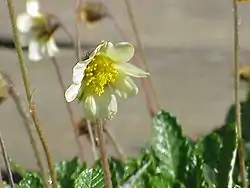Dryadoideae
The Dryadoideae subfamily of the Rosaceae consists of four genera,[1] all of which contain representative species with root nodules that host the nitrogen-fixing bacterium Frankia.[2] They are subshrubs, shrubs, or small trees with a base chromosome number of 9, whose fruits are either an achene or an aggregate of achenes.[1]
| Dryadoideae | |
|---|---|
 | |
| Dryas × suendermannii | |
| Scientific classification | |
| Kingdom: | Plantae |
| Clade: | Tracheophytes |
| Clade: | Angiosperms |
| Clade: | Eudicots |
| Clade: | Rosids |
| Order: | Rosales |
| Family: | Rosaceae |
| Subfamily: | Dryadoideae (Lam. & DC.) Sweet |
| Genera | |
| |
Taxonomic history
The subfamily has at various times been separated as its own family (Dryadaceae), or as a tribe (Dryadeae) or subtribe (Dryadinae).[3]
References
- Potter D, Eriksson T, Evans RC, Oh S, Smedmark JEE, Morgan DR, Kerr M, Robertson KR, Arsenault M, Dickinson TA, Campbell CS (2007). "Phylogeny and classification of Rosaceae". Plant Systematics and Evolution. 266 (1–2): 5–43. doi:10.1007/s00606-007-0539-9..
- Swensen SM, Mullin BC (1997). "The impact of molecular systematics on hypotheses for the evolution of root nodule symbioses and implications for expanding symbioses to new host plant genera". Plant and Soil. 194 (1/2): 185–192. doi:10.1023/A:1004240004063. JSTOR 42948119..
- J. L. Reveal. "Indices Nominum Supragenericorum Plantarum Vascularium – RA-RZ".
External links
 Media related to Dryadoideae at Wikimedia Commons
Media related to Dryadoideae at Wikimedia Commons Data related to Dryadoideae at Wikispecies
Data related to Dryadoideae at Wikispecies
This article is issued from Wikipedia. The text is licensed under Creative Commons - Attribution - Sharealike. Additional terms may apply for the media files.